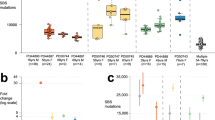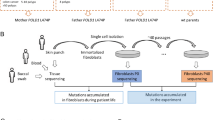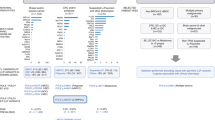Abstract
Inherited defects of base excision repair have not been associated with any human genetic disorder, although mutations of the genes mutM and mutY, which function in Escherichia coli base excision repair, lead to increased transversions of G:C to T:A1,2,3,4. We have studied family N, which is affected with multiple colorectal adenomas and carcinoma but lacks an inherited mutation of the adenomatous polyposis coli gene (APC) that is associated with familial adenomatous polyposis5. Here we show that 11 tumors from 3 affected siblings contain 18 somatic inactivating mutations of APC and that 15 of these mutations are G:C→T:A transversions—a significantly greater proportion than is found in sporadic tumors or in tumors associated with familial adenomatous polyposis. Analysis of the human homolog of mutY, MYH6, showed that the siblings were compound heterozygotes for the nonconservative missense variants Tyr165Cys and Gly382Asp. These mutations affect residues that are conserved in mutY of E. coli (Tyr82 and Gly253). Tyrosine 82 is located in the pseudo-helix-hairpin-helix (HhH) motif and is predicted to function in mismatch specificity7. Assays of adenine glycosylase activity of the Tyr82Cys and Gly253Asp mutant proteins with 8-oxoG:A and G:A substrates show that their activity is reduced significantly. Our findings link the inherited variants in MYH to the pattern of somatic APC mutation in family N and implicate defective base excision repair in predisposition to tumors in humans.
This is a preview of subscription content, access via your institution
Access options
Subscribe to this journal
Receive 12 print issues and online access
$209.00 per year
only $17.42 per issue
Buy this article
- Purchase on Springer Link
- Instant access to full article PDF
Prices may be subject to local taxes which are calculated during checkout





Similar content being viewed by others
References
Nghiem, Y., Cabrera, M., Cupples, C.G. & Miller, J.H. The mutY gene: A mutator locus in Eschericia coli that generates G:C to T:A transversions. Proc. Natl Acad. Sci. USA 85, 2709–2713 (1998).
Michaels, M.L. & Miller, J.H. The GO system protects organisms from the mutagenic effect of the spontaneous lesion 8-hydroxyguanine (7,8-dihydro-8-oxoguanine). J. Bacteriol. 174, 6321–6325 (1992).
Moriya, M. & Grollman, A.P. Mutations in the mutY gene of Escherichia coli enhance the frequency of targeted G:C to T:A transversions induced by a single 8-oxoguanine residue in single-stranded DNA. Mol. Gen. Genet. 239, 72–76 (1993).
Thomas, D., Scot, A.D., Barbey, R., Padula, M. & Boiteux, S. Inactivation of OGG1 increases the incidence of G:C to T:A transversions in Saccharomyces cerevisiae: Evidence for endogenous oxidative damage to DNA in eukaryotic cells. Mol. Gen. Genet. 254, 171–178 (1997).
Fearnhead, N.S., Britton, M.P. & Bodmer, W.F. The ABC of APC. Hum. Mol. Genet. 10, 721–733 (2001).
Slupska, M.M. et al. Cloning and sequencing a human homolog (hMYH) of the Escherichia coli mutY gene whose function is required for the repair of oxidative DNA damage. J. Bactiol. 178, 3885–3892 (1996).
Guan, Y. et al. MutY catalytic core, mutant and bound adenine structures define specificity for DNA repair enzyme superfamily. Nature Struct. Biol. 5, 1058–1064 (1998).
Lindahl, T. Instability and decay of the primary structure of DNA. Nature 362, 709–715 (1993).
Ames, B.N. & Gold, L.S. Endogenous mutagens and the causes of aging and cancer. Mutat. Res. 250, 3–16 (1991).
Groden, J. et al. Identification and characterization of the familial adenomatous polyposis-coli gene. Cell 66, 589–600 (1991).
Kinzler, K.W. et al. Identification of FAP locus genes from chromosome 5q21. Science 253, 661–665 (1991).
Sulekova, Z. & Ballhausen, W.G. A novel coding exon of the human adenomatous polyposis coli gene. Hum. Genet. 96, 469–471 (1995).
Peltomaki, P. Deficient DNA mismatch repair: a common etiologic factor for colon cancer. Hum. Mol. Genet. 10, 735–740 (2001).
Shibutani, S., Takeshita, M. & Grollman, A.P. Insertion of specific bases during DNA synthesis past the oxidation-damaged base 8-oxodG. Nature 349, 431–434 (1991).
Roldan-Arjona, T. et al. Molecular cloning and functional expression of a human cDNA encoding the antimutator enzyme 8-hydroxyguanine-DNA glycosylase. Proc. Natl Acad. Sci. USA 94, 8016–8020 (1997).
Sakumi, K. et al. Cloning and expression of cDNA for a human enzyme that hydrolyzes 8-oxo-dGTP, a mutagenic substrate for DNA-synthesis. J. Biol. Chem. 268, 23524–23530 (1993).
Kohno et al. Genetic polymorphisms and alternative splicing of the hOGG1 gene that is involved in the repair of 8-hydroxyguanine in damaged DNA. Oncogene 16, 3219–3225 (1998).
Kinzler, K.W. & Vogelstein, B. Lessons from hereditary colorectal cancer. Cell 87, 159–170 (1996).
Porello, S.L., Williams, S.D., Kuhn, H., Michaels, M.L. & David, S.S. Specific recognition of substrate analogs by the DNA mismatch repair enzyme mutY. J. Am. Chem. Soc. 118, 10684–10692 (1996).
Porello, S.L., Leyes, A.E. & David, S.S. Single-turnover and pre-steady-state kinetics of the reaction of the adenine glycosylase mutY with mismatch-containing DNA substrates. Biochemistry 37, 14756–14764 (1998).
Chmiel, N.H., Golinelli, M.P., Francis, A.W. & David, S.S. Efficient recognition of substrates and substrate analogs by the adenine glycosylase mutY requires the C-terminal domain. Nucleic Acids Res. 29, 553–564 (2001).
Lu, A.L., Tsai-Wu, J.J. & Cillo, J. DNA determinants and substrate specificities of Escherichia coli mutY. J. Biol. Chem. 270, 23582–23588 (1995).
Dietmaier, W. et al. Diagnostic microsatellite instability: Definition and correlation with mismatch repair protein expression. Cancer Res. 57, 4749–4756 (1997).
Ishioka, C. et al. Detection of heterozygous truncating mutations in the BRCA1 and APC genes by using a rapid screening assay in yeast. Proc. Natl Acad. Sci. USA 94, 2449–2453 (1997).
Cheadle, J.P. et al. Long-read sequence analysis of the MECP2 gene in Rett syndrome patients: Correlation of disease severity with mutation type and location. Hum. Mol. Genet. 9, 1119–1129 (2000).
Jones, A.C., Sampson, J.R., Hoogendoorn, B., Cohen, D. & Cheadle, J.P. Application and evaluation of denaturing HPLC for molecular genetic analysis in tuberous sclerosis. Hum. Genet. 106, 663–668 (2000).
Beroud, C. & Soussi, T. APC gene: database of germline and somatic mutations in human tumours and cell lines. Nucleic Acids Res. 24, 121–124 (1996).
Joslyn, G. et al. Identification of deletion mutations and three new genes at the familial polyposis locus. Cell 66, 601–613 (1991).
Antonarakis, S.E. & The Nomenclature Working Group. Recommendations for a nomenclature system for human gene mutations. Hum. Mutat. 11, 1–3 (1998).
Acknowledgements
We thank A. Wilkie, I. Frayling and R. Snell for advice; I. Tomlinson for advice and primers for exons 1–3 and 5–14 of APC; M.M. Slupska for genomic sequence spanning the MYH locus; M. Krawczak for statistical assistance; J. Best, J. Myring, S. Palmer-Smith, M. McDonald, L. Parry, A. Radcliffe, N. Dallimore and C. Simpson for help with sample collection and preparation; P. Davies for help with dHPLC analysis; and S. Owen and D.S. Jackson for clinical assistance. This work was supported by grants from the King Saud University through the Saudi Cultural Bureau, Tenovus, and from the National Institutes of Health. S.S.D. is an A.P. Sloan research fellow and A.L.L. is an NIH predoctoral trainee.
Author information
Authors and Affiliations
Corresponding author
Rights and permissions
About this article
Cite this article
Al-Tassan, N., Chmiel, N., Maynard, J. et al. Inherited variants of MYH associated with somatic G:C→T:A mutations in colorectal tumors. Nat Genet 30, 227–232 (2002). https://doi.org/10.1038/ng828
Received:
Accepted:
Published:
Issue Date:
DOI: https://doi.org/10.1038/ng828
This article is cited by
-
Targeted next-generation sequencing of 21 candidate genes in hereditary ovarian cancer patients from the Republic of Bashkortostan
Journal of Ovarian Research (2023)
-
Quality of life after prophylactic surgery for colorectal adenomatous polyposis
International Journal of Colorectal Disease (2023)
-
Superior rectal artery preservation to reduce anastomotic leak rates in familial adenomatous polyposis patients treated with total colectomy and ileorectal anastomosis
Techniques in Coloproctology (2023)
-
Genotype–Phenotype Correlations in Autosomal Dominant and Recessive APC Mutation-Negative Colorectal Adenomatous Polyposis
Digestive Diseases and Sciences (2023)
-
The noncoding RNAs regulating pyroptosis in colon adenocarcinoma were derived from the construction of a ceRNA network and used to develop a prognostic model
BMC Medical Genomics (2022)



